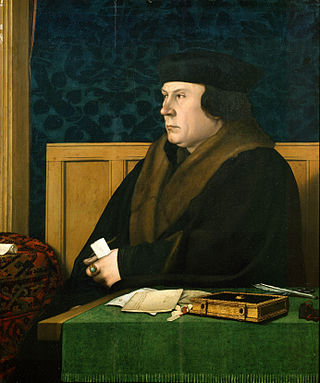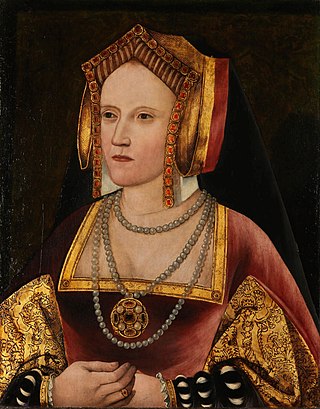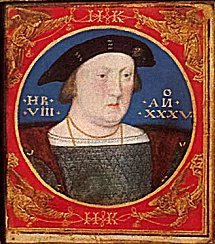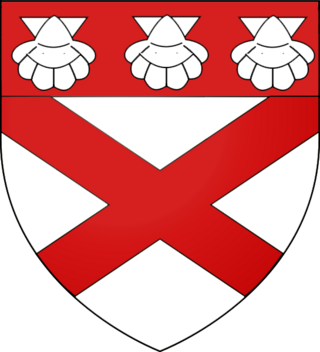Related Research Articles

Henry VIII was King of England from 22 April 1509 until his death in 1547. Henry is best known for his six marriages, and for his efforts to have his first marriage annulled. His disagreement with Pope Clement VII about such an annulment led Henry to initiate the English Reformation, separating the Church of England from papal authority. He appointed himself Supreme Head of the Church of England and dissolved convents and monasteries, for which he was excommunicated by the pope. Henry is also known as the "father of the Royal Navy" as he invested heavily in the English fleet, establishing a standing navy which he expanded from seven to some fifty ships over his lifetime, and developed its command structure.

Thomas Wolsey was an English statesman and Catholic bishop. When Henry VIII became King of England in 1509, Wolsey became the king's almoner. Wolsey's affairs prospered and by 1514 he had become the controlling figure in virtually all matters of state. He also held important ecclesiastical appointments. These included the Archbishopric of York—the second most important role in the English church—and that of papal legate. His appointment as a cardinal by Pope Leo X in 1515 gave him precedence over all other English clergy.

The House of Tudor was a royal house of largely Welsh and English origin that held the English throne from 1485 to 1603. They descended from the Tudors of Penmynydd and Catherine of France. Tudor monarchs ruled the Kingdom of England and its realms, including their ancestral Wales and the Lordship of Ireland for 118 years with five monarchs: Henry VII, Henry VIII, Edward VI, Mary I and Elizabeth I. The Tudors succeeded the House of Plantagenet as rulers of the Kingdom of England, and were succeeded by the House of Stuart. The first Tudor monarch, Henry VII of England, descended through his mother from a legitimised branch of the English royal House of Lancaster, a cadet house of the Plantagenets. The Tudor family rose to power and started the Tudor period in the wake of the Wars of the Roses (1455–1487), which left the main House of Lancaster extinct in the male line.

Year 1515 (MDXV) was a common year starting on Monday of the Julian calendar.

Thomas Cromwell, briefly Earl of Essex, was an English lawyer and statesman who served as chief minister to King Henry VIII from 1534 to 1540, when he was beheaded on orders of the king, who later blamed false charges for the execution.

Antonio Vivarini was an Italian painter of the early Renaissance-late Gothic period, who worked mostly in the Republic of Venice. He is probably the earliest of a family of painters, which was descended from a family of glassworkers active in Murano. The painting dynasty included his younger brother Bartolomeo and Antonio's son Alvise Vivarini.

In common parlance, the wives of Henry VIII were the six queen consorts of King Henry VIII of England between 1509 and his death in 1547. In legal terms, Henry had only three wives, because three of his marriages were annulled by the Church of England. However, he was never granted an annulment by the Pope, as he desired, for Catherine of Aragon, his first wife. Annulments declare that a true marriage never took place, unlike a divorce, in which a married couple end their union. Along with his six wives, Henry took several mistresses.

George Talbot, 4th Earl of Shrewsbury, 4th Earl of Waterford, 10th Baron Talbot, KG, KB, PC was the son of John Talbot, 3rd Earl of Shrewsbury, and Lady Catherine Stafford, daughter of the 1st Duke of Buckingham. He also held the subsidiary titles of 13th Baron Strange of Blackmere and 9th Baron Furnivall.

Gianfrancesco Penni (1488/1496–1528), also known as Giovan Francesco, was an Italian painter. His brother Bartolommeo was an artist of the Tudor court of Henry VIII, and another brother, Luca, ended up as one of the Italian artists of the School of Fontainebleau.

The Serjeant Painter was an honourable and lucrative position as court painter with the English monarch. It carried with it the prerogative of painting and gilding all of the King's residences, coaches, banners, etc. and it grossed over £1,000 in a good year by the 18th century. The work itself involved painting the palaces, coaches, royal barges, and all sorts of decorations for festivities, which often had to be designed as well. The actual involvement of the serjeant painters in this gradually declined. The post itself fell out of use in the 18th century, after a period when "fine art" painters were appointed, and expected to supervise rather than execute decorative painting, for a good salary.

Lucas Horenbout, often called Hornebolte in England, was a Flemish artist who moved to England in the mid-1520s and worked there as "King's Painter" and court miniaturist to King Henry VIII from 1525 until his death. He was trained in the final phase of Netherlandish illuminated manuscript painting, in which his father Gerard was an important figure, and was the founding painter of the long and distinct English tradition of portrait miniature painting. He has been suggested as the Master of the Cast Shadow Workshop, who produced royal portraits on panel in the 1520s or 1530s.

The artists of the Tudor court are the painters and limners engaged by the monarchs of England's Tudor dynasty and their courtiers between 1485 and 1603, from the reign of Henry VII to the death of Elizabeth I.
Anthony Toto or "Antony", real name Antonio di Nunziato d'Antonio (1498–1554), was an Italian painter and architect at the English court.
Nunziato d'Antonio di Domenico, known as Nunziata (1468–1525) was an Italian painter, fireworks artist, and bombardier of Renaissance Florence. None of Nunziata's works can be identified today. Most of what we know about him comes from a single passage by Giorgio Vasari, in the 1568 edition of the Vite, within the Life of Ridolfo, David, and Benedetto Ghirlandaio. Too young to have known Nunziata personally, Vasari shaped him into a literary character: the joking painter in the tradition of Franco Sacchetti's novelle about Giotto and the fabled Buffalmacco. Nunziata belonged to the class of plebeian artists, and Vasari generally omitted their works. His story represents a part of Florentine art outside Vasari's canon, that became art history's. His son Antonio, also a painter, left to work in England in 1519, and as Anthony Toto became court artist or Serjeant Painter to Henry VIII and Edward VI.

Luca Penni (c.1500/1504–1556) was an Italian painter of the 16th century best known for his work in France as part of the First School of Fontainebleau. He was nicknamed Le Romain.

Gilbert Tailboys or Talboys, 1st Baron Tailboys of Kyme was an English courtier and Member of Parliament during the reign of Henry VIII of England.
Antonio Bonvisi was an Anglo-Italian merchant in London. He was also a banker, and employed by the English government, as well as being an agent for the Italians appointed as Bishop of Worcester. He was on good terms with the English humanists of the time, and a close friend of Thomas More.
Sir Humphrey Wingfield was an English lawyer and Speaker of the House of Commons of England between 1533 and 1536.
The More was a 16th-century palace in the parish of Rickmansworth, Hertfordshire, England, where Catherine of Aragon lived after the annulment of her marriage to Henry VIII. It had been owned by Cardinal Wolsey. It lay at the northeast corner of the later More Park estate on the edge of the Colne flood plain. The Treaty of the More was celebrated here by Henry VIII and the French ambassadors. In 1527, the French ambassador, Jean du Bellay, thought the house more splendid than Hampton Court. Nothing now remains above ground. The site is a scheduled ancient monument. In the grounds of the school exist parts of at least two large stone pillars approximately one metre in length which are said to be part of the original manor.
Sir Amias Paulet was an English soldier, official, and sheriff of Somerset and Dorset.